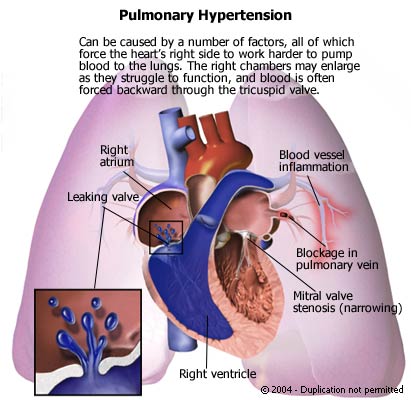3
Contents
A diagnostic evaluation should begin with an echocardiogram (ECHO) just as what happened with you. If you really have a problem, a repeat ECHO would show progression of disease during this interval. In addition there care a variety of other tests that might be ordered include:
Blood Tests
- Complete metabolic panel (CMP): Examines liver and kidney function
- Autoantibody blood tests, such as ANA, ESR, and others: Screens for collagen vascular diseases
- Thyroid stimulating hormone (TSH): A screen for thyroid problems
- HIV: A screen for human immunodeficiency virus
- Arterial blood gases (ABG): Determines the level of oxygen in arterial blood.
- Complete blood count (CBC): Tests for infection, elevated hemoglobin, and anemia
- B-type natriuretic peptide (BNP): A marker for heart failure
Other Tests
- Cardiac ECHO: Uses sound waves to show the function of the right ventricle, to measure blood flow through the heart valves, and then calculate the systolic pulmonary artery pressure.
- Chest X-ray: Shows an enlarged right ventricle and enlarged pulmonary arteries.
- Six minute walk test: Determines exercise tolerance level and blood oxygen saturation level during exercise.
- Pulmonary function tests: Evaluates for other lung conditions such as chronic obstructive pulmonary disease and idiopathic pulmonary fibrosis among others.
- Polysomnogram or overnight oximetry: Screens for sleep apnea (results in low oxygen levels at night).
- Right heart catheterization: Measures various heart pressures (ie, inside the pulmonary arteries, coming from the left side of the heart), the rate at which the heart is able to pump blood, and finds any leaks between the right and left sides of the heart.
- Ventilation perfusion scan (V/Q scan): Looks for evidence of blood clots along the pathway to the lungs.
- Pulmonary angiogram: Looks for blood clot blockages in the pulmonary arteries.
- Chest CT scan: Looks for blood clots and other lung conditions that may be contributing to or worsening pulmonary hypertension.
If it shows a problem with the left side of your heart then treatment is aimed correction or control of your heart problem. Your previous ECHO probably did not show a problem on the left side, or you would have been told about it.
If this part is cleared, the next step involves your lungs and the circulation to your lungs. Because there so many prossibilites, it is useless to speculate what might be the case: the CAT scan will give a lot of information that will dictate the next steps.
Once a diagnosis is made (may take a number of more tests), treatment consists of correcting the underlying problem if possible.


Comments 1
Pingback: Obesity and a decreased heart function - Cardiac Health